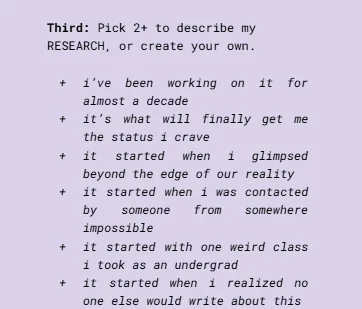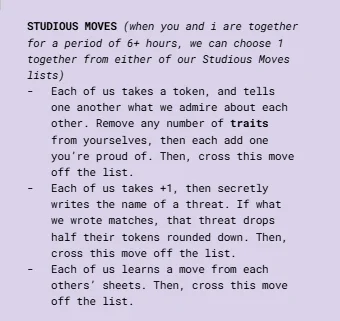Kenzie’s Project is a surreal horror tabletop RPG developed by stargazersasha (Sasha Winter). It depicts the struggles of trying to survive in a bizarre academic setting. Since it’s a role-playing game, players have the freedom to fully personalize their experience, meaning that every playing session will be different. This is a game for exactly three players, who each play as a character and a threat. Each character has its “project”, that they have to advance in order to push away the threats and reach a satisfactory conclusion for the narrative.
I worked with four other translators, dividing the word count as equally as possible. After everyone finished their share, I was responsible for the final revision of the whole text, in order to ensure consistency, clarity and naturality. Although I was the only one in a different time zone, we were able to make it work with the help of instant messaging apps and scheduling voice calls.
Translating instructions
Although it might seem straightforward at a first glance, translating rules is actually quite complex. You have to make sure that the instructions are easy to understand and follow, otherwise the players will likely give up and possibly even request a refund. Analog games, unlike videogames, don’t have as much visual context to give you clues on what something means; Kenzie’s Project fully relies on words only.

KP has a very unique style: the instructions are presented to the player by the character, who uses the first person. E.g.: “Pick 2+ to describe my RESEARCH”. At first, this caused us to perceive a certain degree of differentiation between player and character, which felt odd for a game in which the player is supposed to get into the role and feel like they are the character. As a group, we debated on whether to keep it like this or change it to “your research”, but after voting, we decided to keep that little quirk, respecting the creator’s intention.
One instance when this dynamic became a little too confusing was “when you and i are together for a period of 6+ hours, we can choose 1 together from either of our Studious Moves lists”. Our final translation was “depois que o jogo passar de 6 horas, podemos escolher em conjunto 1 Jogada de Estudo de qualquer uma das nossas listas”.

Our second big discussion was about which grammatical mood we should use: imperative vs. infinitive. Some of us felt that the imperative (e.g., “faça” instead of “fazer”) would amplify even further the divide between player and character. Again, we each exposed our point of view, voted, and the conclusion was that the target audience would not find this excessively confusing, and the imperative mood felt more natural.
One of our most frequent questions to the creator was whether she meant to use “you” as individual or plural, as we wanted to make it very clear when a move was meant to be individual or happen between 2 or 3 players. We also aimed to avoid any assumptions about the gender of the players. In Portuguese, even the word for “player” (“jogador”) is gendered, so we had to replace it with options such as “pessoa” (person), which does not vary based on gender (it’s always feminine), and “participante” (participant), which, if you avoid using an article (o/a), can be understood as neutral, such as in “cada participante” (“each participant”).
Even though, grammatically, the masculine gender is understood as neutral, nowadays that is no longer perceived as fair by people who do not identify as men. It also creates many biases around which activities are seen as “for boys” or “for girls”, and gone are the times when only men were allowed to play games.
We are aware that perfect inclusivity is something that’s very hard to attain, especially considering the challenges that gender-neutral language can create in terms of readability. We did use the neutral, scarcely-accepted “e” ending for gendered words that could not be replaced, such as “professore” (the professor) and “reitore” (the dean). However, everywhere else, we tried to find other alternatives to minimize the impact on grammar, changing word classes and even rewriting full sentences.
As gender neutrality is still a relatively recent concept, some group members were under the impression that they had to "neutralize" words that did not refer to people, such as possessive pronouns, or words that never had any gender variation to begin with, such as “fantasmas”, (ghosts) “espíritos” (spirits), "ciclista" (biker; but in this case you have to find a way to omit the article). In this regard, this project was a great learning opportunity for the linguists that had less experience in this particular matter.
In these changing times, we did what we could with the limited resources we have nowadays as linguists, taking into account the compromises we have to make when we're working with a group. Even if our translation is not perfect inclusivity-wise, I hope non-binary players can appreciate our effort in every sentence we got right.
Style & flavor text
Kenzie’s Project is a game with a very clear stance on some very important topics. It mostly appeals to young people with non-standard identities, who are burnt out due to a system that is brutally unfair. One of its main themes is the oppressive nature of academia, and so we understood that every "sin" against grammar was actually an act of resistance. Take the following example:

This excerpt is a stream of consciousness that gives the player a glimpse on the personality of the character named “the candle”. As you can observe, there’s almost no punctuation, and no capitalization at all. These parts of the game are stylized as a transcription, but the lack of formality also serves to make the characters feel more real. This aspect was preserved in our translation.
We quickly realized that these sentences were purposely context-free; that means the translation had to be left equally vague, as to stimulate the players’ creativity and encourage them to incorporate these words into the many different scenarios they could imagine.
To me, this kind of flavor text is especially delicious to translate, and my hope is that anyone who plays Kenzie’s Project can enjoy it as much as I personally did, imagining the endless possibilities for backstories and intricate relationships that these characters could develop with each other.

